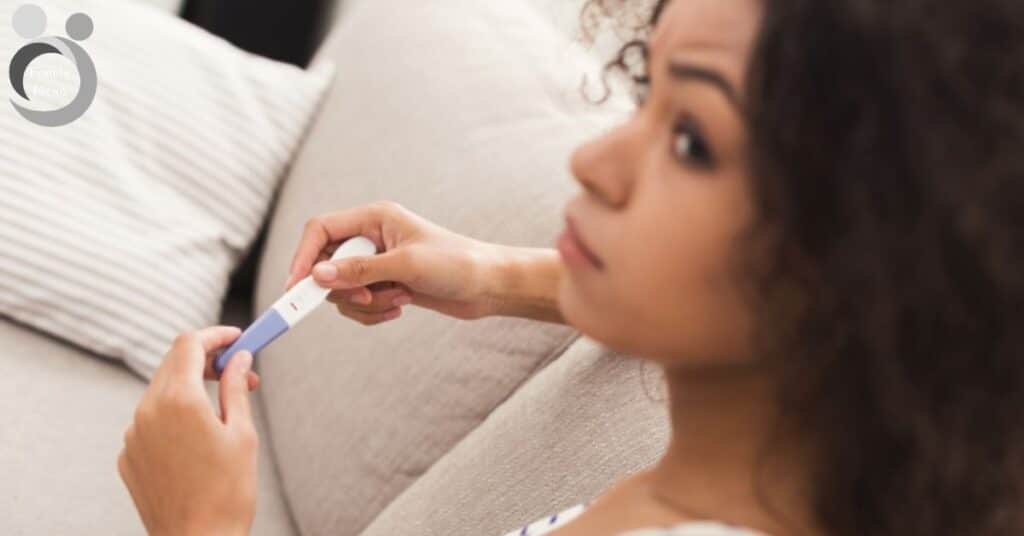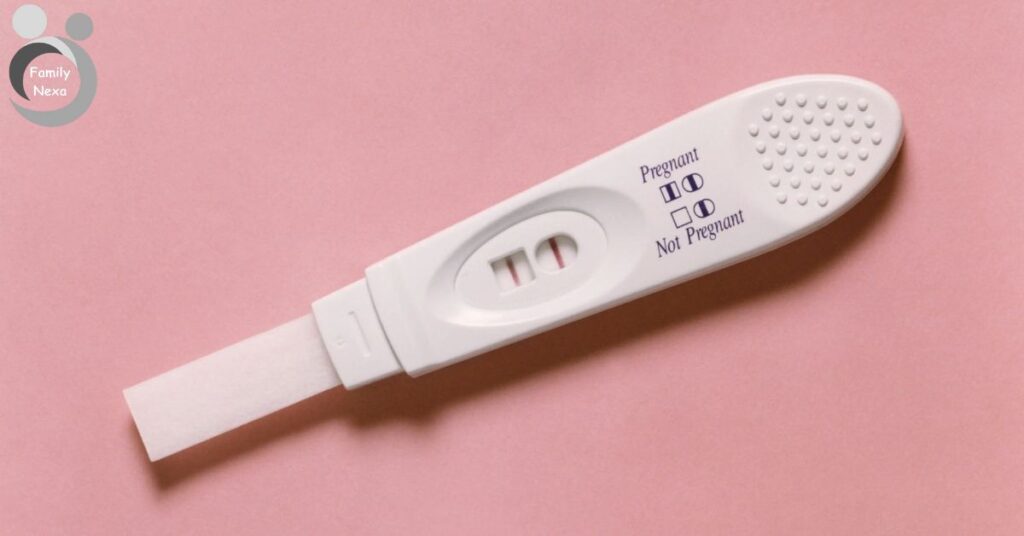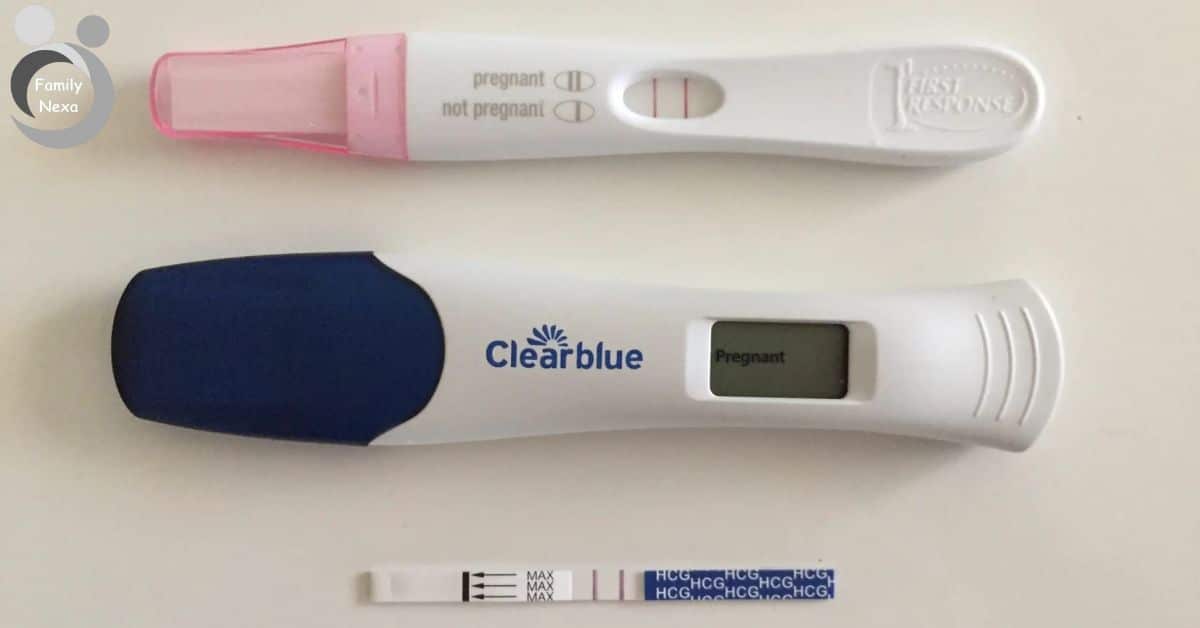A dye stealer pregnancy test is an exciting milestone for expectant mothers. When the test line steals dye from the control line and becomes darker than the control, it generally indicates high hCG levels. This article covers everything you need to know about dye stealer pregnancy tests.
What Is A Dye Stealer Pregnancy Test?
A dye stealer pregnancy test refers to a positive pregnancy test where the test line is significantly darker than the control line. This happens when there are very high levels of the pregnancy hormone hCG (human chorionic gonadotropin) in the urine.
HCG is the hormone detected by home pregnancy tests. As pregnancy progresses, hCG levels rise rapidly, doubling every 48-72 hours in early pregnancy. Dye stealer tests occur when the hCG level is high enough that most or all of the dye gets absorbed by the test line rather than the control. This causes the test line to become obviously darker.
Is It Possible To Get A Dye Stealer When Pregnant?
Yes, it is definitely possible to get a dye-stealing positive pregnancy test. In fact, many freshly pregnant women will get dye stealers when levels of the pregnancy hormone hCG are high.
HCG levels peak at around 10-12 weeks of pregnancy. So this is often when very dark test lines are seen. However, some women with high hCG can get dye stealers even in very early pregnancy.
Pregnancy Test Progression
- A dye stealer doesn’t usually happen with the first positive pregnancy test. HCG needs time to build up.
- Initially, the test line may be faint. It starts light and gets progressively darker each day as hCG rises.
- By around the time of a missed period, the line is typically decently dark but still lighter than the control.
- Within days after a missed period, the test line often “steals” more dye and becomes as dark or darker than the control line.
So in summary – faint line turning dye stealer typically takes 4+ weeks pregnant. But very high initial hCG can sometimes turn tests into dye stealers much sooner.
An Image Of A Dye Stealer Pregnancy Test
Below is an example of what a dye stealing pregnancy test looks like:

As you can see, the test line on the right is significantly darker than the control line on the left. This test has “stolen” most of the dye, leaving little for the control line.
Why Dye Stealer Happens
There are a few reasons why dye stealing happens on pregnancy tests:
- High hCG: The most common reason is high hCG levels in the urine. The test line reacts with hCG, so more hormone = darker line.
- Test sensitivity: Some tests are more sensitive and turn dye stealing positive quicker.
- Concentrated urine: Darker and more concentrated urine can accentuate the dye stealing effect.
- TWINS: Very high initial hCG levels can indicate twins or multiples. With two placentas secreting hCG, levels are higher faster.
So in summary, having a dye stealing pregnancy test is mostly about having a high blood concentration of hCG. Things like concentrated urine or a sensitive test accentuate it.
What Might Cause hCG Levels To Fluctuate?
There are several things that could potentially cause hCG levels to go up and down during early pregnancy:
- Inconsistent urine dilution: Drinking more or less fluids before a test impacts concentration.
- Test sensitivity differences: Results can vary slightly between test brands.
- Implantation timing: Later implantation means slower initial hCG rise.
- Multiple pregnancy: Twins or more means higher hCG.
- Molar pregnancy complications: Where tissue develops into an abnormal growth in the womb.
- Miscarriage: Falling hCG levels indicate loss of pregnancy.
So while normal hCG levels steadily rise in early pregnancy, there are some situations that can cause fluctuations. Urine dilution and test brands are common reasons.
What Is The hCG Level During Pregnancy?
- 3 weeks – 5 to 50 mIU/ml
- 4 weeks – 5 to 426 mIU/ml
- 5 to 6 weeks – 18 to 7,340 mIU/ml
- 7 to 8 weeks – 1,080 to 56,500 mIU/ml
- 9 to 12 weeks – peak of around 100,000 mIU/ml
- Second and third trimesters – levels decline and plateau around 10,000 to 30,000 mIU/ml
So hCG is low after conception, rapidly increasing through the first trimester. Levels peak around 10-12 weeks before dropping to a lower plateau for the remainder of pregnancy.
Questions Related To Dye Stealer Pregnancy Test Meaning
There are some common questions related to the meaning of dye stealing pregnancy tests:
Is A Dye Stealer A Sign Of A Healthy Pregnancy?
In most cases, a dye stealing test indicates a healthy pregnancy with high hCG levels as expected. So it’s a very positive sign. However, it doesn’t guarantee a healthy pregnancy outcome.
Around 1% of pregnancies with high initial hCG levels can indicate issues – like miscalculated dates, multiples, or molar pregnancies. But these are quite rare outcomes.
So in summary yes – for most women, a dye stealing test is a great early indicator that hCG levels are rising nicely and things appear on track. But as always, regular prenatal checkups with an OB-GYN are important too.
Does A Dye Stealer Mean You Have Twins?

While a dye stealing pregnancy test can happen with a single healthy pregnancy, it is more common in twin and multiple pregnancies.
With two placentas secreting hCG instead of one, hCG levels typically start higher and rise faster in twin pregnancy. So there is an increased chance of early dye stealing tests.
However, around 70% of pregnancies with very high initial hCG levels do turn out to be singletons. But it’s still smart to prepare for the possibility of twins when you get an early dye stealer pregnancy test. Discuss it with your doctor.
What Does A Faint Line In A Pregnancy Test Mean?
A faint line in a pregnancy test means a small amount of hCG has been detected – indicating pregnancy. The level is still low but rising. The line starts light and gradually darkens as hCG increases.
While a faint line is considered positive, it usually means you are testing very early and levels may be under 25 mIU/ml. Doctors recommend retesting every 2 days until the line darkens further before confirming pregnancy.
What Does Evaporation Line Pregnancy Test Mean?
An evaporation line on a pregnancy test means a thin, usually colorless line appears where the positive line should be after the 10 minute interpretation window. It is caused by urine evaporating and leaving behind a stain the shape of the test line.
Evap lines show up after as much as 60 minutes. They are always negative results and indicate no hCG has been detected. Only lines that appear within the time frame count as positive.
What Is A Control Line On A Positive Pregnancy Test?
The control line on a home pregnancy test serves an important role. It indicates whether the test has flowed correctly and has the capacity to work.
The control line uses different reagents and antibodies to the test line. Its job is not to measure pregnancy, but instead make sure the urine and dye have properly flown across the test. Always ensure there is a control line present when interpreting pregnancy test results, no matter positive or negative.
Why Is Your Pregnancy Test Negative At Night And Positive In The Morning?
It is quite common for pregnancy tests taken in the evening to show up negative, while morning tests show a clear positive line.
There are two reasons this pregnancy phenomenon frequently happens:
- Urine dilution: We tend to drink more fluids across the day. Night urine is often more diluted than early morning samples.
- HCG circulation: hCG is emitted into blood and urine in pulses, rather than continuous production. More hCG makes its way into urine in early mornings.
So the reason morning tests turn earlier positive is due to the double-whammy of both more concentrated urine and a built-up surge of circulating hCG in your system by the morning.
What Is The Hook Effect Pregnancy Test?
In very rare cases, an overly high level of hCG can make very progressed pregnancy tests turn unexpectedly faint or even negative. This is called the hook effect.
Home pregnancy tests are designed and calibrated to detect hCG between set levels in early pregnancy. After hCG passes a certain very high threshold, the test line antigen can get overloaded and unable to bind any more h
Links provided by Claude may not always be valid or up to date. We appreciate your patience as we work to improve link accuracy.
Should You Expect A Darker Test Line Every Day On A Pregnancy Test?
It’s normal to wonder if pregnancy tests should progressively get darker day after day. But this isn’t always the case.
Due to natural fluctuations in hCG production plus variables with urine dilution or test sensitivities, progression is rarely perfectly consistent. The overall trend is increasing darkness over weeks – but expect some ups and downs along the way.
Don’t overly analyze single daily test changes. Look at the bigger hCG trajectory over a week or more to gauge if levels are appropriately rising.
Some key things to keep in mind with hCG fluctuations:
- Average hCG double time is 48-72 hours in early pregnancy.
- Doubling times can vary hugely between different women.
- Urine dilution impacts how dark test lines appear.
- Different test batch sensitivities alter line darkness.
The darkness of pregnancy tests is just a rough qualitative guide for rising hCG levels. Only quantitative blood tests drawn two days apart can truly determine if your hCG is doubling appropriately.
What Are The Signs Of Rising hCG Levels?
Some signs that align with rising hCG levels in early pregnancy include:
- Darkening pregnancy test lines
- Nausea and vomiting
- Fatigue
- Tender and swollen breasts
- Frequent urination as kidneys start processing extra blood volume
- Slight spotting with embryo implantation
- Cramping and bloating as uterus expands
If combined with positive pregnancy tests, these types of symptoms suggest hCG is following a normal trajectory. Lack of symptoms cannot diagnose issues with hCG. Only blood level monitoring or scans determine problems.
How To Do A Dye Stealer Pregnancy Test?
Performing a pregnancy to check if you have a dye stealer is easy.
The process is the same as taking any at-home urine hCG test:
- Use first morning urine when hCG levels are concentrated.
- Take a home pregnancy test kit avoid expired tests.
- Read pack instructions on how to collect and process urine.
- Start test timer straight after application window.
- Check the test when the time is complete – within 5 minutes max.
- Interpret by comparing test line and control line darkness.
Ideally, confirm with 2 different brands if the first gives a dye stealing result to check it’s genuine. First Response and Clearblue tests have good sensitivities for early dye stealers.
When Is The Best Time To Do A Pregnancy Test- Morning Or Evening?
The best time of day during the early days of suspecting pregnancy is to test your first urination in the morning.
As explained previously, FMU (first morning urine) is less diluted and also captures any hCG buildup overnight. This accentuates trace levels, making pregnancy detection 3-4 days sooner than when testing later in the day.
Testing early morning also prepares you get faster answers before facing the stresses of a new day.
If morning testing isn’t convenient however, know late afternoon (like 4pm) is typically better than middle of day where fluid intake dilutes urine most.
How Soon Can A Pregnancy Test Become Positive?
Current pregnancy tests can detect hCG levels between 5 to 25 mIU/ml on average. At earliest, faint positives are possible:
- 8 DPO – About 10% of women get early faint positives around 8 days past ovulation/fertilization due to early implantation.
- 9 DPO – 20% of pregnant women see very faint test lines begin.
- 10 DPO – Around 40% of early pregnancy tests start showing faint positive results.
- 11 to 12 DPO – Over half of tests turn positive by just before an expected period.
So while possible 8-9 DPO, it generally requires excellent timing plus a sensitive pregnancy test to get an early positive. Wait until at least the day of your expected period to more reliably test.
When Should You Get A Dye Stealer Pregnancy Test?

Dye stealing positive pregnancy tests normally happen around the time of or within a week after a missed period when hCG levels in the body are rising exponentially in early pregnancy.
Some unique cases can turn tests into early dye stealers including:
- Testing with an extra early detector pregnancy test around a week before period. First Response tests, for instance, are very sensitive.
- Having unusually high initial hCG levels indicative of multiple pregnancy – like twins.
- Miscalculated last menstrual period dates that you’re actually further along.
- Struggling with long and irregular cycles that delay ovulation.
While possible earlier, questionable cycle dates is the most common reason for surprisingly early dye-stealing test lines. Otherwise getting a dye stealer around a missed period is typical.
Is It Possible To Dilute hCG Levels By Drinking Water?
Drinking extra fluids before taking a home pregnancy test can dilute hCG in urine below detectable levels – essentially masking early pregnancy.
But drinking more water does NOT change actual systemic levels of hCG in blood serum or pregnancy tissue. So it cannot flush out or terminate an existing pregnancy by dilution once implantation occurs and hCG is measurable.
However, intentionally hydrating excessively against doctors orders to avoid positive pregnancy testing is medically risky for women experiencing issues like ectopic pregnancy.
Can Your hCG Levels Decrease Without Causing A Miscarriage?
In most normal early pregnancies, hCG levels consistently double every 48-72 hours for the first few weeks. So any decreases of hCG not associated with an obvious heavy bleed are concerning.
However, minor drops within the normal range of variation may not always result in miscarriage. Things like changeable test sensitivity, uneven urine dilution, and natural hCG spikes can slightly influence perceived levels without pregnancy loss.
But rapid halving or falling hCG often precedes later ultrasound confirmed failure – even without major bleeding if surrounded by pregnancy tissue offering support for some time.
Discuss any concerns about unusual variable pregnancy test results with your doctor. Only quantitive blood hCG monitoring determines issues accurately – avoid overinterpreting urine tests.
Is It True That Dehydration Has An Effect On hCG Levels?
Yes – clinical studies show that dehydration significantly increases blood plasma and urine hCG levels as the volume of fluid in the body drops. Concentrated urine can more than double measurable hCG.
This is why pregnancy testing with first morning urine gives earlier and darker test line results. Overnight water fasting concentrates any hCG present by morning.
But remembers – dehydration only concentrates existing hCG – it doesn’t create it. To get a true positive pregnant test result hCG first must be present from embryo implantation. Concentrating urine via dehydration cannot fake a real pregnancy.
Is There A Way You Can Monitor Your hCG Levels While Still Staying Home?
Some at-home options exist to quantitively track rising hCG levels without visiting a lab for blood draws:
- Urine hCG dipstrips – Measure hormone quantity via color calibration. Less accurate than blood but cheap for monitoring pregnancy progress.
- Digital home pregnancy tests – Advanced Clearblue weeks estimators use hCG ranges. But limited usefulness for miscarriage tracking and not as precise as bloodquantification.
- Telehealth – New generation services from companies like Wisp offer physician-prescribed hCG level blood testing with at-home phlebotomy sample collection kits. Then ship samples to partner lab for analysis. Provides accuracy of blood with telemedicine convenience.
Quantitive hCG assays are optimal for detailed monitoring. While lab blood testing remains most universal, innovative telehealth services help bridge access gaps.
When Do The Level Of hCG Reach Their Highest Point?
The peak period where hCG levels reach their maximum concentration during pregnancy is at around 10-12 weeks gestation.
This aligns with when most women start entering the second trimester,complete embryonic development, surpass the highest miscarriage risk period, and the placenta reaching full functioning capacity secreting hormones.
Average peak hCG levels during this time range from around 70,000 to above 200,000 milliunits. Then levels decline but plateau through later pregnancy to support continued growth.
How Can You Tell You Had A Chemical Pregnancy?
A chemical pregnancy describes a very early loss before or around expected menstruation. Named because while fertilization and implantation occur, the pregnancy never becomes clinically detectable or sustainable in development.
Signs of possible chemical pregnancy include:
- Brief period being slightly late or unusual light spotting noticed around expected period.
- Possible very faint positive on an early sensitive home pregnancy test that quickly fades or turns negative within a few days. No darkening over 48+ hours indicates non-viable pregnancy.
- Potential key early pregnancy symptom like breast soreness that disappears after a couple of days.
- Heavy menstruation following above that seems greater than typical period.
- No signs of conception on early ultrasounds if tested.
With hCG levels under 10 mIU, chemical losses don’t always clearly diagnose. Around 30-40% pregnancies end shortly after implantation, often undiagnosed.
What Should I Eat To Boost My hCG Levels?
While a healthy balanced diet supports normal pregnancy, no specific foods scientifically increase hCG levels once pregnant. However, ensuring adequate key nutrition helps facilitate healthy placenta and embryo development that regulates hCG.
Some examples of beneficial pregnancy superfoods:
- Protein like eggs, chickpeas, salmon
- Vitamin C fruits – oranges, grapefruits, strawberries
- Folate leafy greens – spinach, kale
- Vitamin D dairy – milk, yogurt
- Iron fortified cereals & lentils
- Iodine enriched breads and seafood
Remember, diet cannot correct underlying issues causing abnormally low or falling hCG levels like miscarriage. But aiming for nutritious antioxidant-rich meals can help optimize normal pregnancy processes.
Does Everyone Get A Dye Stealer Pregnancy Test?
While most women will eventually see darkened pregnancy tests indicating rising hCG levels later on, not all tests turn into obvious “dye stealers” with test lines notably darker than controls.
Dye stealing tests depend on having high enough hCG to soak up excess indicator dye coupled with a sensitive test.
Reasons it may not happen:
- Less hCG-sensitive test brand used
- Normally progressing hCG but remaining within ‘standard’ range
- Early miscarriage before levels peak into dye stealer levels
- Rare hCG receptor issues causing weaker test line color
So while nice early reassurance, not observing an obvious dye stealer pregnancy test isn’t itself problematic if levels still increased appropriately.
Should You Do Another Test After A Dye Stealer?
After getting a dye stealing positive pregnancy result, many women logically question whether it’s necessary to keep testing.
Further testing after confirmed dye stealers that remain dark when repeated isn’t required or overly recommended unless concerning symptoms appear.
However, one extra test with a different brand can validate initial early dye stealers results weren’t falsely darkened somehow. After duplicate dark dye stealing lines, additional testing mainly causes unnecessary worry interpreting needless fluctuations.
If you can’t resist repetitive testing anyway, gradually weening off testing over a couple weeks may ease anxieties better than abruptly stopping cold turkey.
Conclusion
Getting a blazing dark dye stealing pregnancy test line is an exciting milestone signaling high rising hCG and expected early pregnancy development. While not guaranteed future healthy pregnancy, it indicates maternal hormone levels within normal high limits.
Dye stealers classically occur around 4+ weeks pregnant approaching the missed period, but can sometimes impressively early if hCG levels production start unusually high. Always retest positives with a different test for validation.
Understand even viable hCG fluctuates though – so don’t panic at an isolated lighter test result amongst progressive darkening. Only quantitive blood hCG testing diagnose issues reliably. Otherwise enjoy your darkening test lines and focus on prenatal health in anticipation of the baby these strong hormones signal is on the way!

I am Emma, a skilled writer and SEO expert. With years of experience in both fields, I love writing helpful articles readers love. I also want the articles to show up high on Google.
My goal is to make content that is both interesting and easy to find online.
I work hard to research topics, choose the right words, and organize information clearly.












